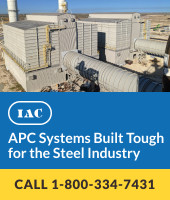Iron & Steel Technology

December Issue Now Online!
Long Products Rolling Technologies
Special Features Include:|
►Steeling the Spotlight: Tallman Technologies |
Table of Contents
52
Investigation of Decarburization of Spring Steel During Hot Rolling
Spring steels are high-quality materials widely used in the automotive, railway and manufacturing industries. To ensure high product quality, the wire rod must exhibit superior surface conditions. Decarburization is a critical parameter that sig-nificantly affects surface quality and reduces fatigue strength performance. In this study, the development of the decarbu-rization structure in spring steel during hot rolling was investigated; the focus has been on when cooling covers were both in open and closed positions during the process of laying head.
60
Analysis of Penetrators Formed in the Welding Line of Electric-Welded Pipes
Due to the high temperatures involved in the production of electric-welded pipes, reoxidation of steel can promote the for-mation of particles rich in SiO2 and MnO along the weld line that are known as “penetrators.” In this work, different pipe samples were analyzed to characterize the typical composition and size of the penetrators found. A methodology was de-veloped to quantify the area occupied by these particles in the fracture surface of Charpy V-Notch test specimens. A rela-tionship was found between the frequency of penetrators and the toughness measured at 0°C. Additionally, thermody-namic calculations were performed to predict the expected composition of penetrators for different steel compositions. Cal-culations were compared with measurements carried out in the present work and reported in the literature, showing rea-sonable agreement.
68
Effect of Mold Electromagnetic Stirring Parameters on Segregation Level of a Medium-Carbon Steel
Oil country tubular goods (OCTG) is a class of steel used for oil and gas exploration in environments where pressure, tem-perature and acid solutions are frequently present. For this application, a fine-tuned combination of mechanical properties and surface quality are mandatory for the well integrity. One of the ways to reduce surface imperfections on the internal surface of pipes is by reducing solidification segregation. Based on that, this study evaluated the effect of varying the elec-trical current of mold electromagnetic stirring on segregation level of continuously cast bars of an OCTG steel. Both macro and microstructural characterization were performed to identify the effects of stirring current intensity. Results showed that too-high current levels increase spot segregation and chemical heterogeneity.
76
Effects of Mn and Mo on Microstructures and Properties of High-Strength and Heavy-Gauge Line Pipe Steel
Alloying elements are a determinative factor to line pipe steel properties wherein high strength (X70, X80) and low-temperature toughness for heavy gauge (≥19 mm) are desirable. These properties are related to microstructures formed during thermomechanical-controlled processing (TMCP). Here, vacuum induction melting, casting and TMCP by pilot-scale rolling are completed for a reference condition and then compared with two independent increases of Mn and Mo content (i.e., five conditions). Microstructures were assessed using optical and scanning electron microscopy including electron backscattered diffraction while tensile testing and drop weight tear tests were conducted to assess the steels’ properties.


